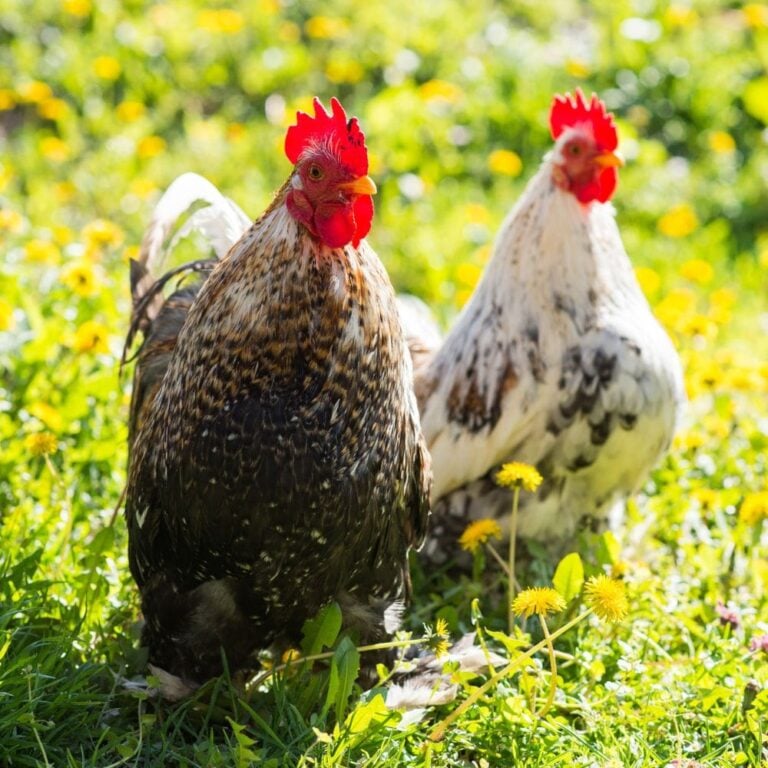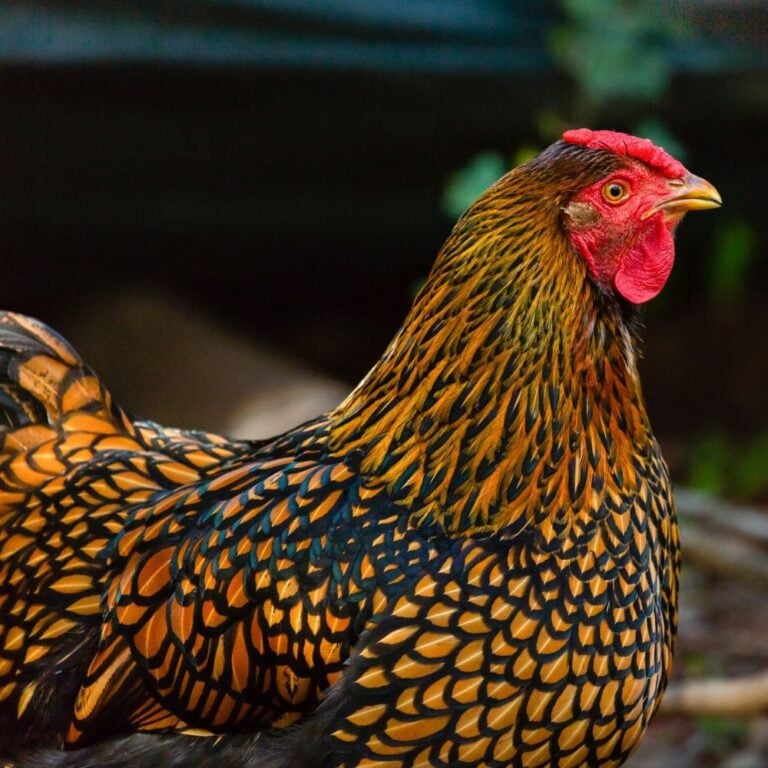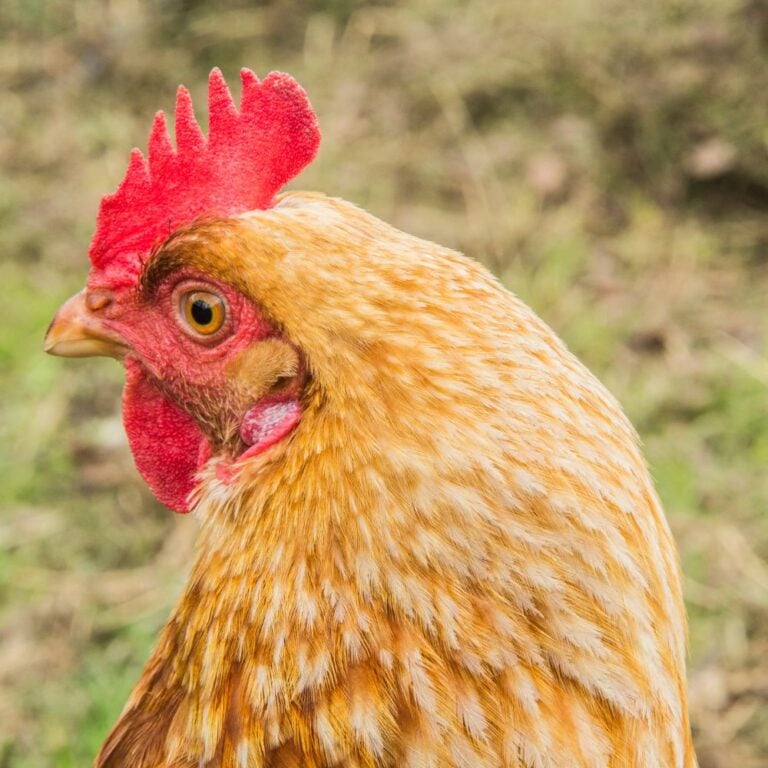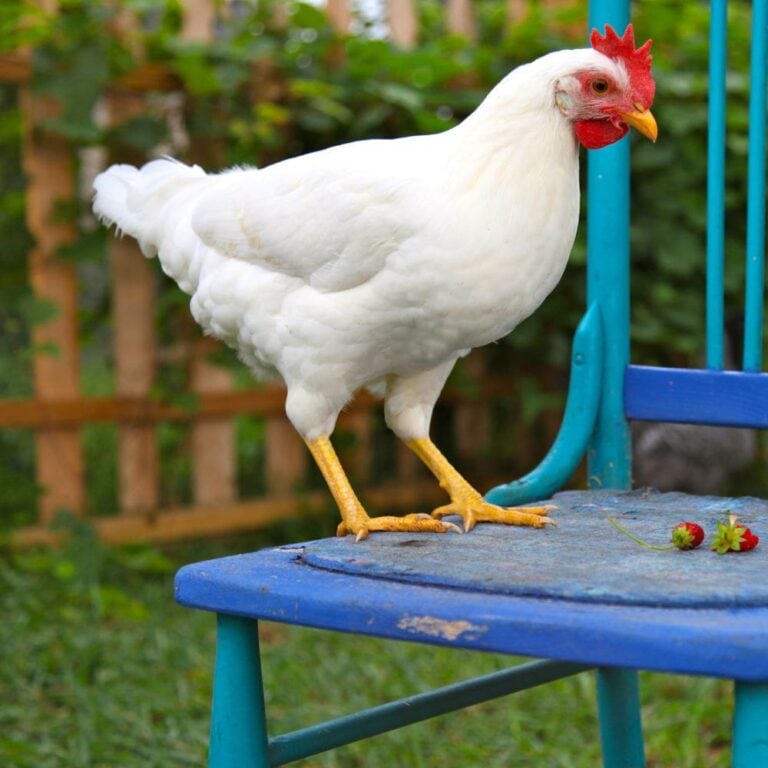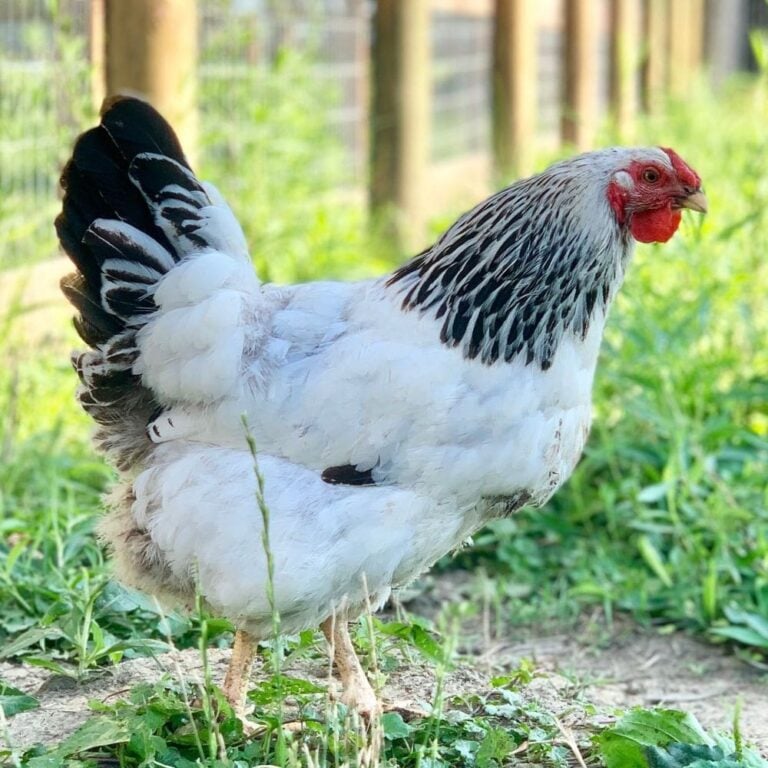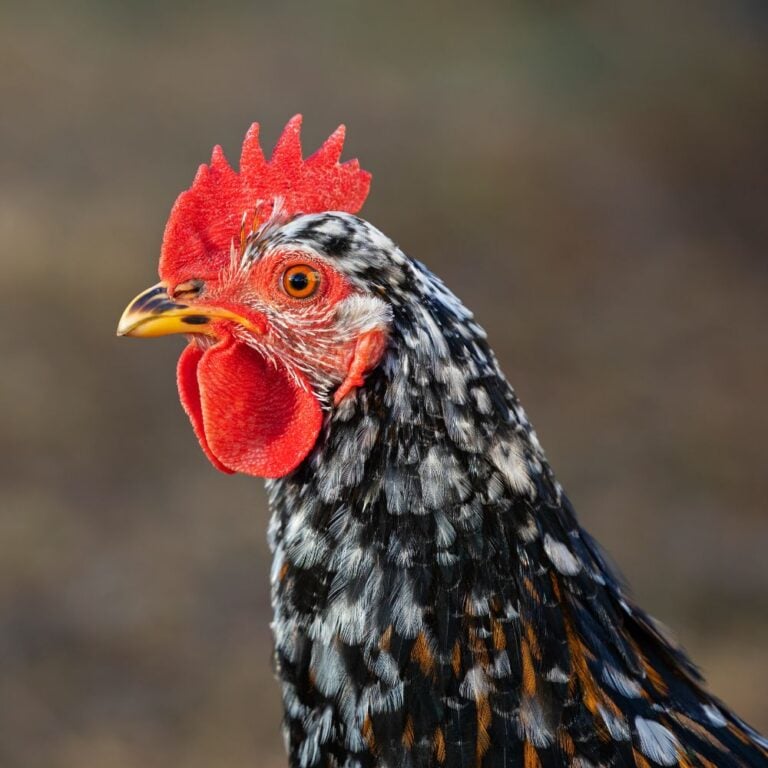Barred Rock Chickens – What’s not to love about this striking breed? Discover all you need to know about this all-time favorite.
When we first started keeping hens, Barred Rocks were our choice. Barred Rock chickens are one of the most well-known breeds out there — and subsequently, one of the most popular.
Once upon a time, our ancestors raised them as a dual-purpose birds with a combination of some of the best farm chicken qualities: docility, hardiness, and broodiness.
These days, this breed is best known for its egg-laying ability and gorgeous plumage.
In this article, you’ll discover facts about these cluckers, recommendations for reliable breeders and hatcheries, whether Barred Rock chickens make great pets, and more!
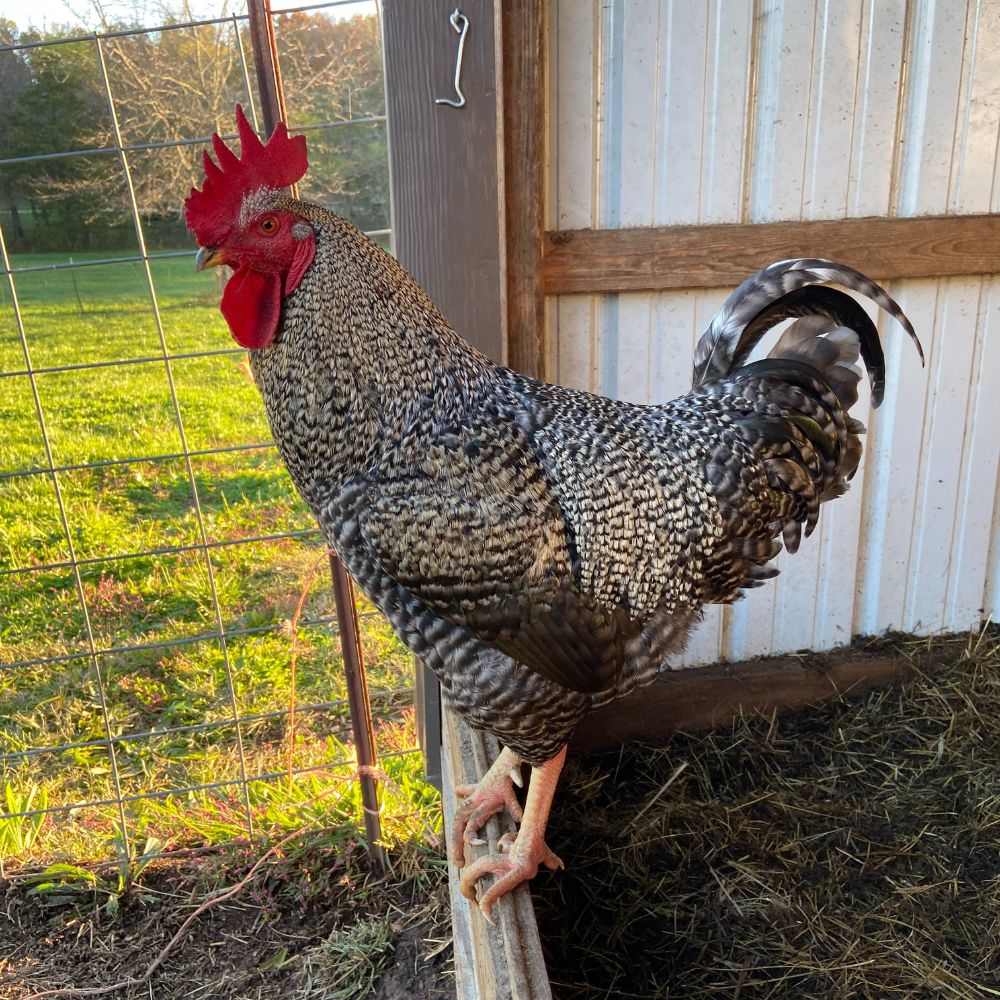
Table of Contents (Quickly Jump To Information)
5 Amazing Barred Rock Chicken Facts
- One of the oldest breeds in America
- First exhibited as a breed in 1869
- “Barred” refers to their feather coloring
- They lay medium to large brown eggs
- The barred color pattern is a dominant sex-linked gene
Breed History
According to the Livestock Conservancy, which promotes heritage livestock breeds, the Barred Rock was developed in America in the middle of the 19th century. It’s not clear exactly who developed the breed, however, it seems these chickens are the product of crossing Spanish, White Cochin, Dominique, Buff Cochin, Black Java, and Brahma chickens.
From the barred version, other types of Plymouth Rock chickens were developed (including white, buff, Columbian, and other combinations). You can read more about Plymouth Rock chickens here for the full list.
They were very popular as an all-purpose breed around the turn of the 20th century and were admitted into the American Poultry Standard of Perfection in 1874.
Barred Rock Chicken Temperament
Are Barred Rock Chickens Friendly?
Yes, Barred Rock chickens are generally friendly, which makes them ideal for families as pets. The roosters are especially calm with both people and other animals. If you want to raise Barred Rocks as pets, it’s best to feed them lots of treats and handle them daily.
You might notice that your hens won’t be as friendly if they’ve “gone broody’ and want to hatch eggs. This is normal, and she will return to being friendly if you help her stop her broodiness or after she’s successfully hatched chicks.
You can learn more about raising people friendly chickens here.
Are Barred Rock Chickens Aggressive?
Generally, no they aren’t. Barred Rock chickens are friendly and docile birds towards humans and other animals.
However, if your chickens don’t have enough space (10 square feet per hen) or you have too many roosters, they might become aggressive toward each other. It’s always best to have 1 rooster for every 10 hens and to make sure everyone has enough space and food to eat.
Are Barred Rocks Noisy?
No, the roosters might crow when they see a predator but are not noisier than other chicken breeds. The hens are very quiet.
Barred Rock Egg Laying Ability
How Long Do Barred Rock Hens Lay Eggs?
Like most hens, Barred Rock chickens will lay the most eggs during 9 months of age until they’re about 3 years old. Most chickens will slow down or stop laying after they turn 3. There will be exceptions; some readers have emailed me with stories about their 7-year-old hen who still puts out eggs 3 times a week. However, most chickens won’t lay eggs consistently when they’re that old.
You should decide what you plan to do with your hens when they stop laying. We personally keep ours and let them live out their lives naturally since they’re pets.
To ensure your hens are in peak condition for egg laying, it’s best to feed them a layer feed with 16% protein and supplement with oyster shells for extra calcium. Research shows that this diet helps them from becoming nutrient deficient (which can cause hens to stop laying eggs).
How Many Eggs Per Year Do Barred Rocks Lay?
A Barred Rock female will lay about 280 eggs per year. They’re actually considered one of the champion egg-laying chicken breeds!
Although the actual amount will vary from bird to bird. To ensure your chickens produce lots of eggs, you should feed them a healthy diet, including a 16% protein layer feed.
Barred Rock chickens lay brown eggs. Their egg size is medium to large.
Do Barred Plymouth Rocks Go Broody?
Yes. Because Barred Rock chickens are a heritage breed, they tend to go broody. When the breed was first developed, modern incubators didn’t exist, so to hatch chicks, a broody hen was required.
You can learn more about hatching chicks here. You can find the best incubators here.
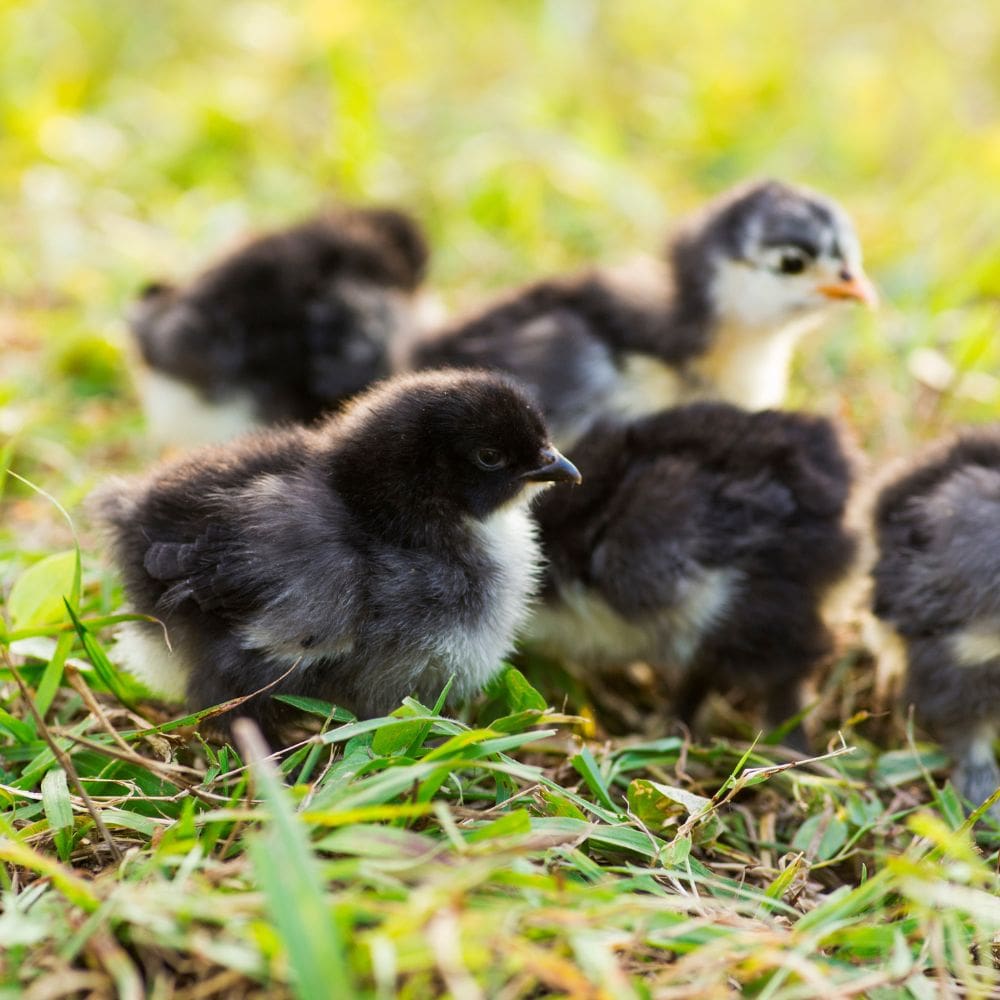
Barred Rock Chicken Appearance
Barred Rock Chicken Coloring
These birds have beautiful black and white feathers that give them the trademark “barred” appearance. They have a single comb with red wattles and ear lobes that show off their health and vigor. They have yellow beaks and feet that give them a friendly, approachable expression.
The roosters have long, black and white striped tail feathers that they lose during fall molting (but they grow back even more beautiful). They do look a lot like the Dominique breed, but there are ways to tell them apart, such as the Dominique’s rose comb. You can read more about that here.
Are Barred Rock and Plymouth Rock Chickens the Same?
Yes, Barred Rock chickens are a variation of the Plymouth Rock chicken. The barred feathers were the first coloring of the Plymouth Rock, and from the Barred Rock, other variations were developing, including:
- White
- Buff
- Silver Penciled
- Partridge
- Columbian
- Blue
How Big Do Barred Rock Chickens Get?
Pretty big – about 9.5 pounds for the roosters and 7.5 for the hens. While there’s not much you can do to influence the size of your chickens, feeding them a high-quality diet will ensure their growth doesn’t get stunted.
If you want to show the breed or just have a pet, you might also be interested in the bantam version. Adorable for sure.
Feeding Barred Rock Chickens
Chicks
As baby chicks, you’ll want to provide your flock with an 18% protein chick starter like this one. The protein is necessary to help them grow correctly. Without it, they might not develop properly and it could affect their lifelong health.
You can also feed them treats such as dried insects, black soldier fly larvae, or mealworms.
Layers
Once your chickens start producing eggs, you’ll want to give them a layer feed and a calcium supplement like oyster shells. Layers need it so they can provide you with yummy eggs. T
he best diet for any hen starts with a 16% protein layer feed and fresh, clean water every day. Roosters can also eat layer feed, although they will probably leave the oyster shells alone.
Barred Rocks are a large chicken breed, but have a very good feed-to-egg conversion ratio – so they don’t need a TON of feed.
You can also feed your hens lots of treats like mealworms. You can discover what chickens eat here, and what they can eat from your garden here.
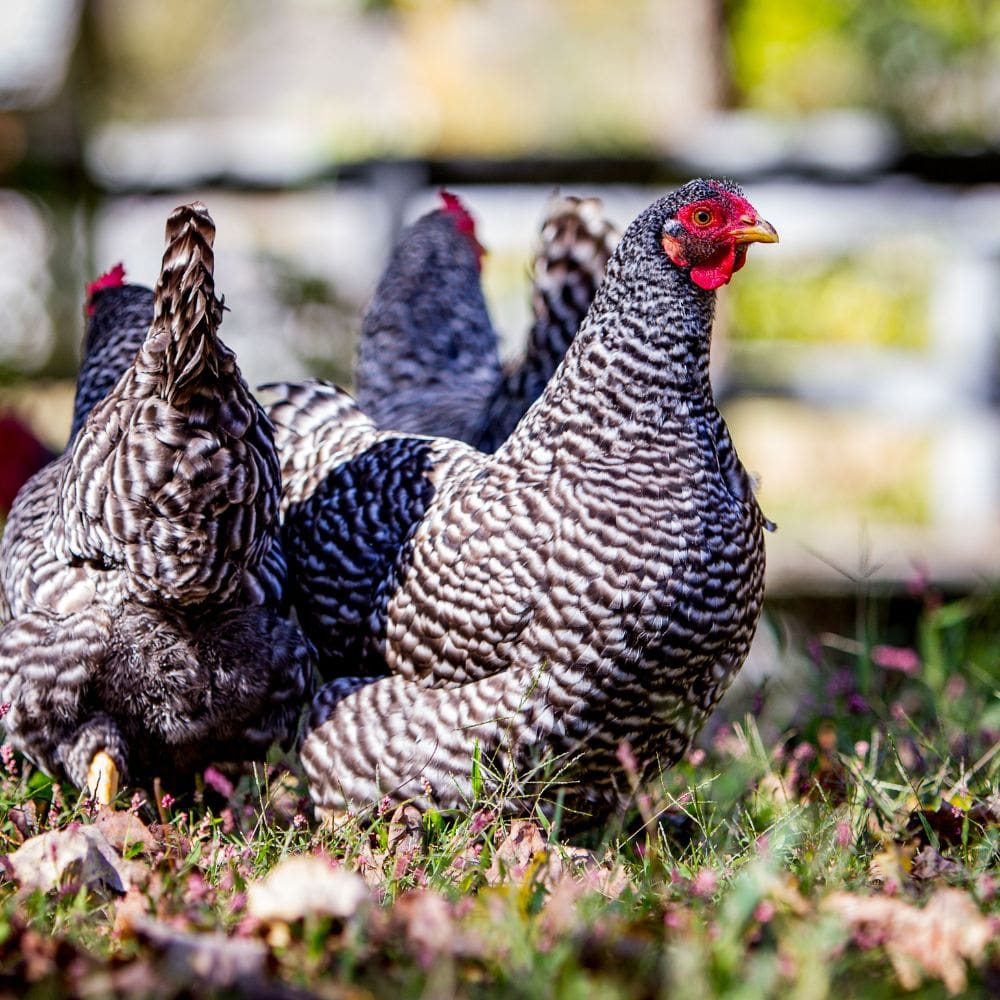
What Kind of Coop Do Barred Rocks Need?
Like all chickens, this breed does better with space to forage and explore. There should be sufficient space inside the coop and run. You should also make sure it has the basic essentials like a roost, waterers, and feeders.
The ideal chicken coop should be:
- Safe from predators
- Well ventilated
- Draft-free
- Easy to clean
- 10 square feet of space per chicken
- Enriched with environmental interest, such as branches and toys
Barred Rocks are fairly large chickens, so to ensure they’re healthy and don’t develop bad habits, make sure their coop has 10 square feet of space per chicken especially if you are keeping them in confinement all the time.
To keep them safe from dogs, raccoons, opossums, and larger predators like bears, make sure your coop is safe.
If you want to build your own coop, there are plans for a predator-proof chicken house here. Make sure you’re using the best chicken wire for your particular coop as well (generally ¼ inch hardware cloth is best).
Barred Rock chickens are very hardy in cold weather, but their coop still needs to keep them dry and warm in the winter. In the summer, they should have access to a well-ventilated coop that’s clean and free of ammonia (clean it weekly). Your coop should have good cross breezes so they don’t overheat.
Breeding Barred Rock Chickens & Genetics
Since the barring genes are common in a lot of chicken breeds, you probably aren’t surprised to learn that breeding Barred Rocks to create other, new hybrids is pretty common. It’s also popular for genetics when trying to create sex-linked chicks.
While we won’t dive too deep into genetics (it’s such a tricky topic!), here’s some interesting information about breeding Barred Rocks!
- The barring gene is dominant.
- A Barred Rock rooster will pass the barring gene to his offspring, however, the Barred Rock hen will only pass the barring gene onto males (which is why you can tell the sex of Sex Linked chicks right after they hatch)
- A barred rooster paired with a non-barred hen won’t produce sex-linked chicks. To create sex-linked chicks, you must pair a rooster who doesn’t carry the barring gene with a purebred barred hen.
You can learn more about how chickens mate here and learn all you ever wanted to know about barring here.
Common Health Issues
Like other chickens, Barred Rocks are susceptible to lice, chicken mites, worms, and other parasites. Bumblefoot is another ailment Barred Rocks can get.
To keep your chickens healthy, you can add herbs to their feed, such as oregano, garlic, and lemon balm. If you don’t want to go to all the trouble of gathering herbs and mixing them up, I recommend checking these herbal blends out.
Where to Buy Barred Rock Chickens
Most major hatcheries and farm stores carry these chickens – you might also see them called “Plymouth Rock” chickens – this is because Barred Rocks are actually a color variation of Plymouth Rocks.
All the hatcheries on this list are good places to buy this breed – it’s probably best to choose a hatchery close to you, so your new chicks don’t have to travel too far before landing on your doorstep.
Always look for healthy, active chicks! If the photos of the babies don’t look great, or they look unhappy or sick, then don’t purchase them.
The top 5 hatcheries I recommend to purchase Barred Rock chickens are:
My Pet Chicken
If you live in the Northeast or Mid-Atlantic, then this hatchery is a great option (note they do ship nationwide). They’re located in Connecticut.
My Pet Chicken sells day-old chicks and 6-week-olds that you can have shipped right to your door. The Barred Rock chickens on their site have gotten many 5-star reviews, with some owners saying their Barred Rock hens were the first to lay eggs.
They also look very full-bodied with soft feathers, which is great. I imagine this is what the Barred Rocks our ancestors raised looked like (rather than some of the scraggly breeds you see today that are bred for egg production only).
Meyer Hatchery
There are many 5-star reviews for the Barred Rock chicks on this website – so it looks like past customers love their chicks! Meyer is located in Ohio, so if you live in the Mid-Atlantic. Northern Midwest, or Kentucky area, this is a good hatchery to order from since your chicks won’t travel too far.
Owners say their babies arrived healthy and have now grown into active layers. The prices at this hatchery are competitive.
Cackle Hatchery
Cackle is located in Lebanon, Missouri, so it’s a good hatchery to buy chicks from if your farm is in the Midwest, Texas, Oklahoma, Nebraska, Kansas, the Dakotas, etc. I personally usually order from this hatchery (they’re about 4 hours from my farm). Every time I’ve ordered from them, the chicks arrived ASAP and in good shape.
Their prices for Barred Rock chicks are reasonable, and they have good customer service. You can read our review of Cackle Hatchery here.
Murray McMurray
Murray McMurray has been around for a while, and they’re located in Iowa. If you live in the Dakotas, Iowa, Minnesota, etc, then this is a good hatchery to order from. I’ve ordered chicks through them once, and it was a good experience.
Their Barred Rocks have many 5-star reviews. Their prices are a bit more expensive than the other hatcheries on this list.
Stromberg Chickens
Stromberg is located in Minnesota, so it’s a good option for our Northern friends (sorry, Canada, I don’t know if they ship to you). Their prices are a little more expensive than other options on this list. On their site, there’s an option to have your chickens vaccinated for Marek’s disease.
There’s not a whole ton of information and photos on their site of the chickens (no photos of the chicks themselves), but this hatchery has a good reputation.
Other Ways To Purchase Barred Rock Chickens
Join Facebook groups and ask for breeder recommendations. Here’s a popular group dedicated to this breed.
Summary
As you can see, there is pretty much nothing bad about the Barred Rock breed. They are a good, solid, heritage breed that is friendly, hardy, and beautiful.
Maat van Uitert is a backyard chicken and sustainable living expert. She is also the author of Chickens: Naturally Raising A Sustainable Flock, which was a best seller in it’s Amazon category. Maat has been featured on NBC, CBS, AOL Finance, Community Chickens, the Huffington Post, Chickens magazine, Backyard Poultry, and Countryside Magazine. She lives on her farm in Southeast Missouri with her husband, two children, and about a million chickens and ducks. You can follow Maat on Facebook here and Instagram here.

